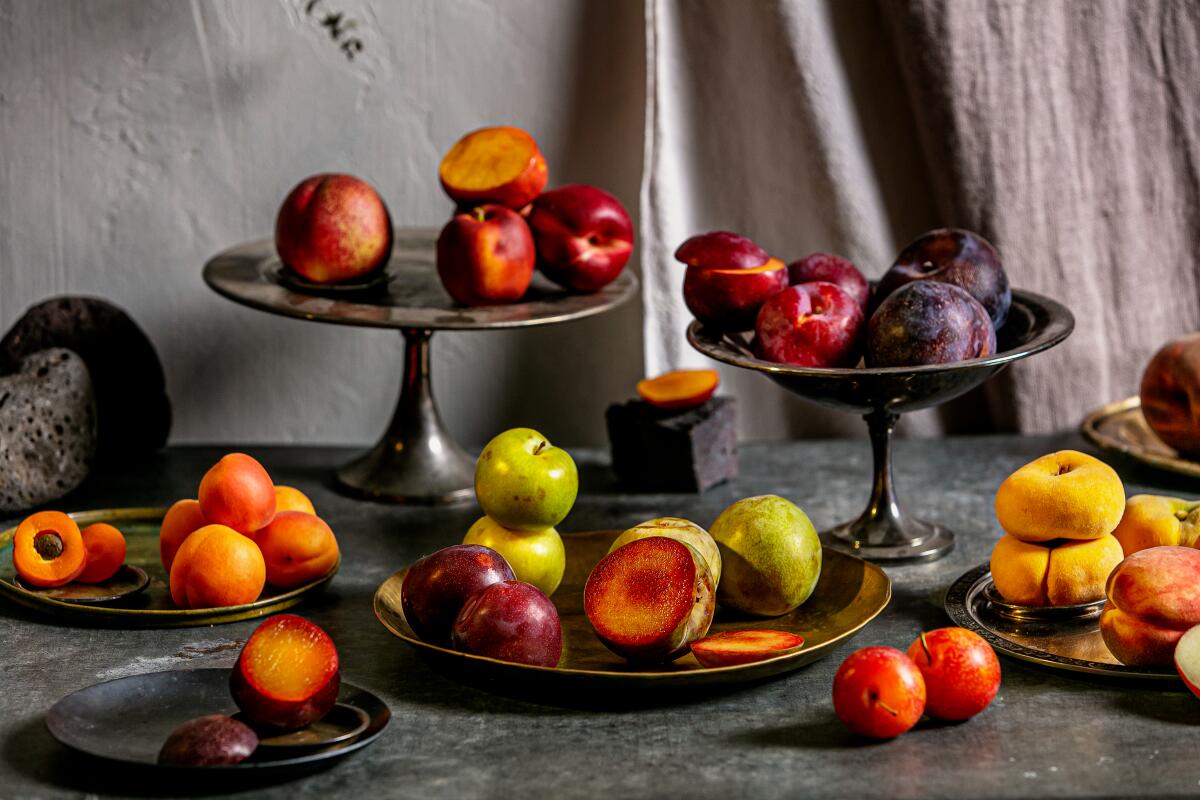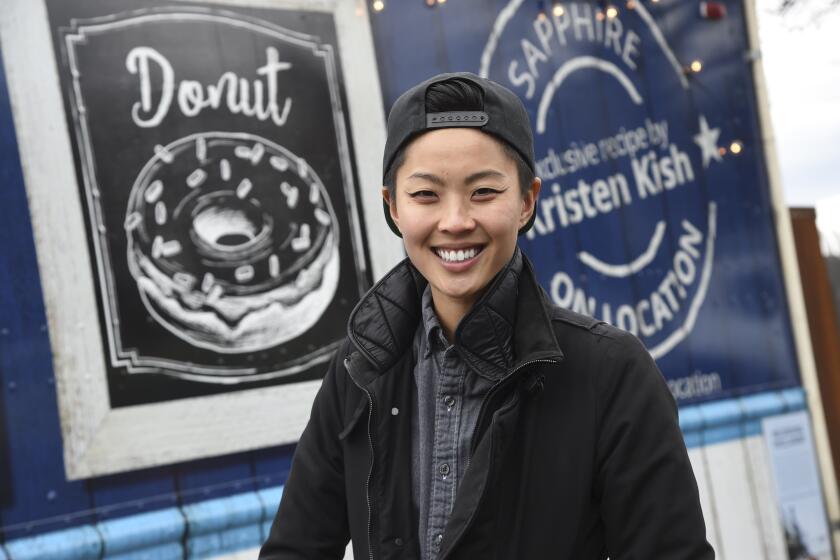‘Black Smoke’ gives African American pitmasters their due
- Share via
When Adrian Miller was writing his first, award-winning book “Soul Food: The Surprising Story of an American Cuisine One Plate at a Time,” he originally planned to include a chapter on barbecue.
In soul food restaurants, barbecued pork is often an option among entrees of oxtails, catfish and fried chicken. And even if the meat has technically been baked and varnished with a sweet tomato glaze rather than smoked over indirect heat, Miller considered barbecue to be as part of the lexicon.
The more he researched and ate, though, he realized the subject of African American barbecue demanded a book of its own. His resolve was steeled after watching a Paula Deen special on the Food Network in 2004. It was dedicated to barbecue, but it didn’t spotlight a single Black expert. As Miller writes in the introduction of “Black Smoke: African Americans and the United States of Barbecue,” “I saw shots of Black people in the background doing the actual work, but they were anonymous and voiceless. … I recall thinking, as I turned off the television, ‘Is this what Black barbecuers have become? They’re just B-roll footage now?’ ”
Enjoying this newsletter? Consider subscribing to the Los Angeles Times
Your support helps us deliver the news that matters most. Become a subscriber.
Miller’s writing style is warm and fast-flowing and sometimes flecked with humor; scholarship anchors all of his work, and there were centuries of mythology, erasure and shifting public tastes to untangle.
(Miller, who refers to himself as a “recovering attorney,” served in the White House as a special assistant to President Bill Clinton with his Initiative for One America. Miller’s second book was “The President’s Kitchen Cabinet: The Story of the African Americans Who Have Fed Our First Families, from the Washingtons to the Obamas.” You might have seen him recently on Netflix’s “High On The Hog,” talking about chefs Hercules and James Hemings with host Stephen Satterfield.)
Barbecue, as destination dining and obsessives’ hobby, has ascended to pop culture status in the last 20 years, so the arrival of “Black Smoke” couldn’t be timelier. Chapters address the topic from prismatic angles: Native American foundations to the techniques that became known as barbecue; the nuanced, often-fraught narratives of African Americans identified as barbecue specialists, beginning with enslaved Africans early in the colonization of North America; Black participation in barbecue circuits (limited, Miller reports; he’s a certified barbecue judge); entrepreneurship and church gatherings; and maddening inconsistencies in media coverage over the decades. He discusses favored cuts (spare ribs have some weighty historical connections) and traces the fierce love of and rivalries around sauce, including shifts in taste from red pepper and vinegar bastes to the embrace of the ketchup-based styles.
In so many ways, Miller makes the case for Black contributions to American barbecue, though his erudition stops him short from claiming complete ownership: “This is not a cool, dispassionate thing to write, but I would love to prove that barbecue has an African origin while simultaneously forming an ‘X’ with my arms across my chest and shouting, ‘Wakanda Forever!’ Unfortunately, it’s not that easy.”
Eat your way across L.A.
Get our weekly Tasting Notes newsletter for reviews, news and more.
You may occasionally receive promotional content from the Los Angeles Times.
I covered the South for most of the first decade of my food writing career, and I always cherished the regional barbecue styles that existed from state to state. Miller points out that Central Texas traditions — the centerpiece of which, of course, is beef brisket cooked to custardy lushness with thick, peppery bark — has become the default American style of barbecue in the new millennium. When done well it is undeniably delicious. The best local upstarts like Moo’s Craft Barbecue in Lincoln Heights and Heritage Barbecue in San Juan Capistrano have built their reputations largely around brisket.
“I understand why people gravitate to that specialty,” Miller said in a phone interview. “What I keep trying to say is, well, when you talk about Texas barbecue, just understand there are several traditions. You’ve got the Central Texas, but you also have the Latino influence of southern Texas, then you have East Texas style, which really descends from enslaved Africans arriving in the 1820s and 1830s making Southern pit barbecue. We have newspaper accounts of enslaved African Americans doing that work.
“I also remind people that barbecue for two centuries was this: digging a trench, filling it with hardwood burning coals and cooking whole animals over that. It wasn’t until the turn of the 20th century that it changes in profound ways. But this is just another example of how resilient African Americans are: Every time barbecue is redefined, if initially there isn’t a strong presence of African Americans cooking that way, in time Black folks adapt and, say, make brisket if that’s what customers want.”
Miller delves into the past as a means to preserve the future of Black barbecue. He name-checks Rodney Scott, the South Carolina pitmaster renowned for his whole-hog prowess who won the James Beard Award for Best Chef: Southeast in 2018. (Scott also recently published a cookbook, “Rodney Scott’s World of BBQ,” written with Lolis Eric Elie.)
Noting the dwindling of Black-owned barbecue restaurants in urban areas across the country, he writes, “This is probably the long-term result of a combination of factors — regular restaurant business attrition, a younger generation uninterested in carrying on the barbecue baton being passed by their parents, and gentrification driving Black businesses out of Black neighborhoods.”
As with everything in our dining culture, the situation is evolving. Miller was finishing the edits on the book as the pandemic crept over the globe. In our conversation, he zeroed in on the circumstances faced by so many of those who feed us: finding an audience without the ballast of a permanent location.
“There are far fewer brick-and-mortar places run by African Americans. The businesses I know that closed had a large dine-in capacity. That’s unfortunate,” he said. “But you know, we’ve got a lot of food trucks. Just look at the brothers and sisters on the side of the road and in the parking lots doing their thing. In a weird way, a lot of Black entrepreneurs may have been COVID ready. They were already focused on takeout due to lack of capital or other reasons.”
The significance of the moment has Miller thinking about his next project: He’s leaning toward a history of African American street vendors.
Have a question?
Other stories
This week Ben Mims kicks off a four-part series, “L.A. in a Jar,” with recipes and techniques for preserving the taste of summer with stone fruit jam. (And if you don’t want to make your own, there’s a list of his favorite local brands of jam.)
I review House of Mandi, a Yemeni restaurant in Anaheim’s “Little Arabia” district serving feasts of lamb and chicken half-buried in spiced rice (the namesake dish, mandi) and stews bubbling volcanically in ways that recall soondubu rushed to the table in Korean restaurants. Check it out.
Jenn Harris is all in on Las Vegas coverage: She shares an uni pasta worth the trip alone and guides you to the best cocktails.
Finally: Two former Trois Mec chefs launch a sandwich pop-up ... and other news from Jean Trinh.

Eat your way across L.A.
Get our weekly Tasting Notes newsletter for reviews, news and more.
You may occasionally receive promotional content from the Los Angeles Times.



